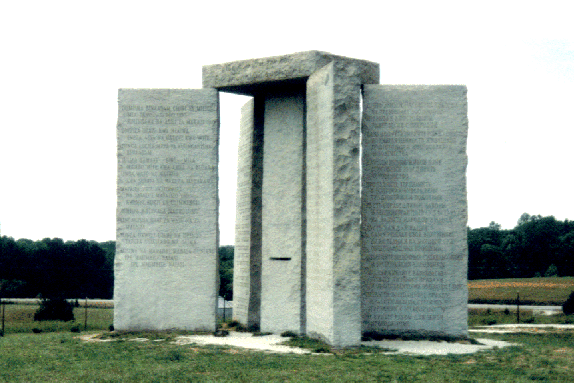Georgia’s Version of Stonehenge
Stonehenge, pictured here, is among the world’s best-known monuments. The collection of standing stones seemingly in the middle of nowhere in particular are prehistoric, dating back at least four thousand years. But beyond that, they’re a mystery — we don’t know who put them there, when, or why.
The Georgia Guidestones aren’t quite as well known. But they look like Stonehenge, kind of, and they’re still kind of mysterious. Let’s take a look.

Here’s what we know about them. First, they’re located in Elberton, Georgia, a rural city of about 90 miles east of Atlanta and not really close to anything of note. They’re made of granite, which shouldn’t be surprising if you’re one of the 4,500 or so people from Elberton — the city claims to be the “granite capital of the world,” after all. Also, the Guidestones aren’t nearly as old as Stonehenge — they were built in 1979 or 1980 and publicly unveiled on March 22, 1980. They’re the brainchild of a guy named Robert C. Christian, except that isn’t his real name, which we don’t know. Actually, we don’t know much about him at all.
At some point in the late 1970s, the mysterious Mr. Christian approached a local granite company with his plans to build a monument for all eternity. Amusing Planet explains:
[Mr. Christian] walked into the office of the Elberton Granite Finishing Company one Friday afternoon in 1979 and announced that he wanted to build a granite monument to deliver a message to humanity. The gentlemen explained to the now deceased Joe Fendley, then president of the Elberton Granite Finishing Company, that the monument had to be capable of withstanding the most catastrophic events, so that humanity would be able to use those guides to reestablish themselves.
Fendley, seeing Christian as a crank, quoted him a price well beyond reasonable, but sometimes, the unreasonable customer can afford such a bill. And that’s what happened here. Christian — backed by “a group which had been planning the Guidestones for 20 years, and which intended to remain anonymous,” per Wikipedia — accepted the offer and Fendley’s team got to work.
While the funders of the Guidestones is opaque, the purpose of them is rather clear. As Wired notes, “what’s most widely agreed upon—based on the evidence available—is that the Guidestones are meant to instruct the dazed survivors of some impending apocalypse as they attempt to reconstitute civilization.” The evidence for that goes beyond that quote from Amusing Planet — the proof is on the stones itself. Each of the four upright stones have ten messages written on them, below, almost certainly designed to be intended for whatever people or culture comes next:
- Maintain humanity under 500,000,000 in perpetual balance with nature.
- Guide reproduction wisely — improving fitness and diversity.
- Unite humanity with a living new language.
- Rule passion — faith — tradition — and all things with tempered reason.
- Protect people and nations with fair laws and just courts.
- Let all nations rule internally resolving external disputes in a world court.
- Avoid petty laws and useless officials.
- Balance personal rights with social duties.
- Prize truth — beauty — love — seeking harmony with the infinite.
- Be not a cancer on the earth — Leave room for nature — Leave room for nature.
And, just to be safe — and this is why there are so many stones — these messages aren’t just written in English. One stone face has it in English, yes, but the other seven have the same text translated into Arabic, Chinese, Hebrew, Hindi, Russian, Spanish, and Swahili, respectively.
For those who are visiting before the end of times, though, there’s more to see. There’s another message just a few feet away, intended for us (probably). Engraved in English are the words “let these be guidestones in an age of reason” with Christian’s name as their “author” (noting that the name is a “pseudonyn,” with that misspelling). And finally, and arguably the peak of the monument’s weirdness, the explanatory stone references a poorly-designed “time capsule”. That section says that the time capsule was “placed six feet below this spot on” a date not specified which is “to be opened on” a date not specified; instead, both lines just end without further instruction.
We will probably never know anymore about the history of the Georgia Guidestones — as the years tick by, so tick away those who may know the truth behind their origin. Instead, there are literally dozens of different theories behind the who and why of the stones, and we shouldn’t expect answers.
Update, July 2022: The Guidestones no longer exist; they were blown up (!), as seen in this video.
Bonus fact: To visit Stonehenge, you need to go to the UK. If you’re in the United States, though, and want to see a reasonable approximation of it, you only need to go to Virginia. On April 1, 2004 (April Fool’s Day, not coincidentally), a man named Mark Cline created something called “Foamhenge,” a replica made out of styrofoam. Through 2016, the exhibit was in Natural Bridge, Virginia — a small, unincorporated area in the center of the state — but it is relocated to another location in Virginia for 2017.
From the Archives: Turkey’s Prehistoric Temple: Like Stonehenge, only older.
Related: This is Spinal Tap. If you don’t know why this is here, you really need to watch this movie.
